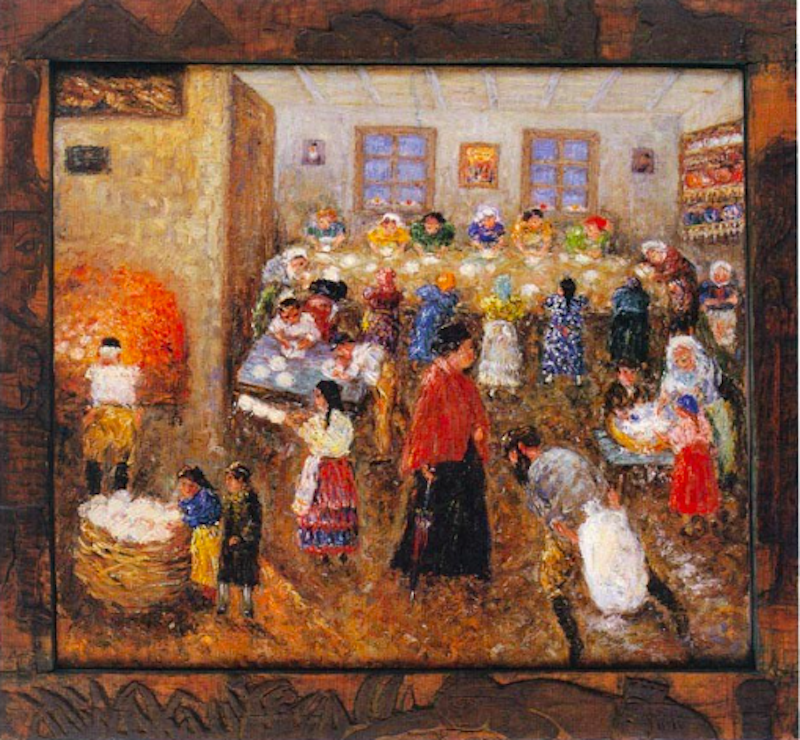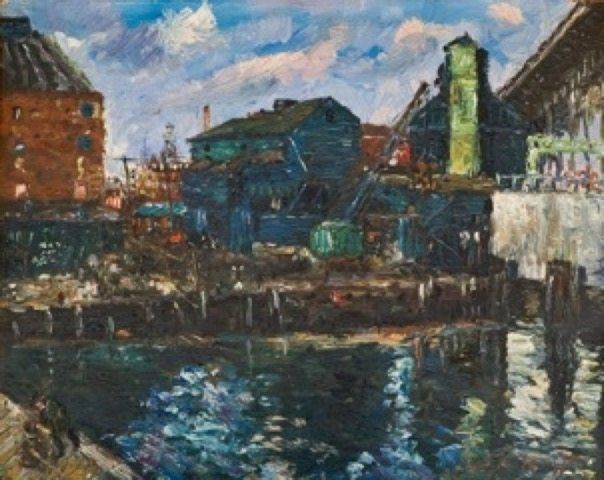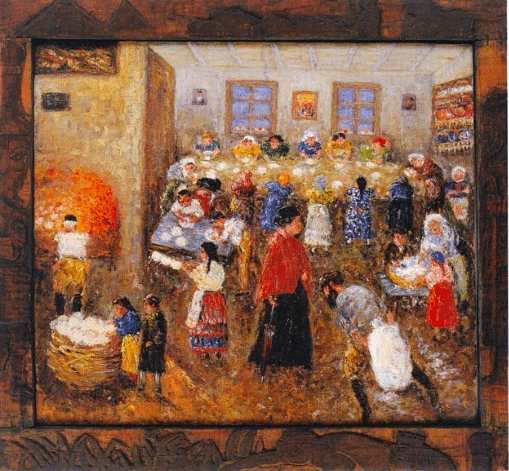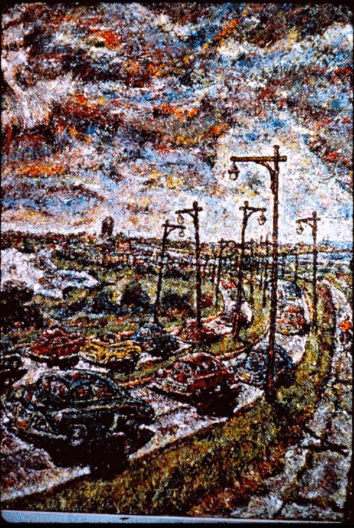Harriet Semegram Talks New Book, Neighborhood Changes & Brooklyn’s Artistic Legacy


Neighbor Harriet Semegram has surprisingly deep and diverse roots in the Ditmas Park arts scene.
More than 50 years ago, she compiled a visual history of Eastern European Jewish life that became the visual inspiration for Fiddler on the Roof. But before this groundbreaking project, Semegram had never made a film in her life — she was a classical singer. And if that isn’t enough to impress, she also pioneered an application of the Alexander Technique for pregnancy and childbirth.
And now, she’s working on a book that will tell the story of a father and son, both artists whose works capture scenes of mid-century Brooklyn. Taken together, the movie and the book will celebrate the legacy of Samuel and Lawrence Rothbort, through Semegram’s unique vision.
The Legacy of Father-Son Brooklyn Painters: Samuel and Lawrence Rothbort
Born in the Bronx, Semegram first encountered Samuel Rothbort after she moved into his Brooklyn neighborhood of Gravesend. On a summer’s day, she happened to peek through the open curtains of his house on East 9th Street and Avenue S, and saw many original paintings decorating the walls. She introduced herself, and in time became his dealer, exhibiting paintings to prospective clients.

But during one visit to the Rothbort home, Semegram saw an unusual piece that stood our from his prolific collection of over 500 impressionistic oil paintings and 200 sculptures. This piece belonged to a series the artist called “memory paintings,” whose more primitive style “recorded the daily life of Eastern European Jews the way I remember seeing it, with my child’s eyes,” Rothbort explained to Semegram.

Semegram was captivated by the work, which revealed a hidden world that she had never seen, even as a Jewish woman. With no prior experience in filmmaking, Semegram was inspired to write and produce a documentary using 215 of Rothbort’s 11 x 14 memory paintings, which she completed in 1961. The result was the Edinburgh Film Festival prizewinning film “The Ghetto Pillow-Memories of the Shtetl.”
As the only visual color record of daily life in the shtetl, the documentary helped preserve the history of Eastern European Jews from 1882–1904. And in 1964, when the film was rented by director Jerome Robbins, it became the visual record for all of the costumes and sets for the original Broadway musical Fiddler on the Roof.
“Well we found out because in 1965 Fiddler on the Roof came out,” Semegram said, “and all the costumes, not the story, but all the costumes and all the sets were from my film.”
As an example, she explained, “There was one watercolor: Rothbort lost his mother to cholera. He was about 10 or 11. He went to the cemetery and there was a yellow finch on the gravestone, which was depicted in the painting. When the curtain came down for the overture [in Fiddler on the Roof], there was the painting but the bird was gone. So with one small change, it became an idea, not a copy. He did that with every set.”
While making the film, Semegram became acquainted with Samuel’s son, Lawrence Rothbort. A high school drop-out, he’d been a conscientious objector during World War II. Following the war, he told his father he wanted to become an artist and Samuel agreed to support him, but commanded him to produce a new painting every single day. “Nature will teach you,” the artist told his son. Both Samuel’s and Lawrence’s paintings would continue to exhibit this aesthetic, painted directly from nature and finished on site, without being retouched later.



Semegram was taken by the younger Rothbort’s work and signed on as his dealer as well, even though his first show hadn’t yielded a single sale. Lawrence struggled to make his mark as an artist. He set up a gallery in a store in Bedford Stuyvesant, and lived in the back with his pregnant wife and two children. By October of 1963, he was exhibiting canvases with price tags from $2,000 and $5,000 in the front-room gallery.
But Lawrence’s life was cut short by an abrupt tragedy. That same month, a stranger entered the gallery with a sawed-off shotgun, Samuel recounted to Semegram. “He asked for money. Lawrence only had $5 left. He refused to give it, and was shot in front of his wife and children.” Semegram was asked to accompany Samuel to identify the body.
In the wake of Lawrence Rothbort’s death, a show of his work was mounted at the Riverside Museum in February, 1964. A contemporary New York Times review noted that, absent the notoriety of his gruesome death, it was “a show that a few months ago seemed as attainable to the artist as the pot of gold of fairy lore.”
But the show did not bring the deceased artist enduring fame, and his father’s reputation never rose to the glory of his contemporary Marc Chagall. But Semegram remained loyal to both painters, continuing to sell their work to the present day.
Building A Home In Ditmas Park
Semegram refused to let the tragedy of Rothbort’s murder shape her life. When she bought her Ditmas Park home the late 60s, Semegram’s friends delivered warnings about Brooklyn neighborhoods. “This is my philosophy: if you want to live in a city, you take the bad with the good. You want to go out to the suburbs? …I said no. But I couldn’t live in Manhattan and work in Manhattan. The energy level was too much.”
She’d lived in Brooklyn since 1954 and used to walk from her apartment on Foster Avenue in spring and summer, admiring the houses in Ditmas Park West. “Someday I will have a house here,” she promised herself.
When they had saved enough to buy, she and her then-husband started house hunting. “I saw a house off Church Avenue, a little cul de sac right across from the Japanese house. Gorgeous house,” Semegram remembered.
Then they found a Ditmas Park home close to Dorchester Road. The agent asked for a $50 deposit, promising to give it back if they changed their mind. Semegram wrote out the deposit from her first independent checking account, she said, “And as the realtor touched the check, another couple came down the stairs and said, ‘We’ll take the house.’ and He said, ‘Not yet!!”
They bought the house in December of 1967. “Everyone screaming at me. ‘You’re out of your mind,’” Semegram said. “‘Don’t buy it. You’re right near Church Avenue. The crime. It’s impossible. Don’t buy it.’ But I’ve been in this house 48 years!”
The house is beautifully decorated with evidence of Semegram’s devotion to art and music. The landscaped yard also echoes her appreciation for the Rothbort’s style, often painted directly from nature.

Semegram has seen considerable changes in Ditmas Park over the years. “Because I cook for myself, my favorite place in the neighborhood is really the Food Co-op,” she said. She remembers the store before it moved to Cortelyou Road; when she joined the newly-founded Co-op 40 years ago on Avenue H, “It was no bigger than my kitchen.”
“The gradual change in Ditmas Park was very slow,” Semegram said. “But the big shift happened quickly. Probably about 18 years ago, prices and real estate started to change. Now in the last four or five years it’s become astronomical.”
She can take credit for some of the changes herself. A classical singer who once performed at Carnegie Hall, Kaufmann Concert Hall and other venues, she “was part of a group that performed Billy Joel’s music at the Loews King to save it in the 70s,” Semegram said. “ And now it’s bought up by a British company and beautifully renovated. It was gorgeous even when it was closed. It was magnificent.”
Semegram seems always to have another tale left to tell. All this time we’ve been talking, she’s barely mentioned her work as a health care professional. A certified, licensed childbirth educator (Lamaze), she had also used the Alexander Technique to improve her vocal range. Semegram recognized these disparate practices could be complementary, and developed the Alexander Technique for pregnancy and childbirth. But afternoon is growing into evening, so those stories will have to wait until this remarkable Ditmas Park woman publishes her own book.
Harriet’s Semegram’s book about her work with the Rothborts is still in development. She still has a limited number of works by Samuel and Lawrence Rothbort available for sale. Go to AskArt.com and search under Samuel Rothbort and Lawrence Rothbort. Her film is available on DVD at the Brooklyn Public Library; search the catalog under “Memories of the Shtetl” to place a copy on hold. It can also be purchased by contacting memories@wonderwoman.com



